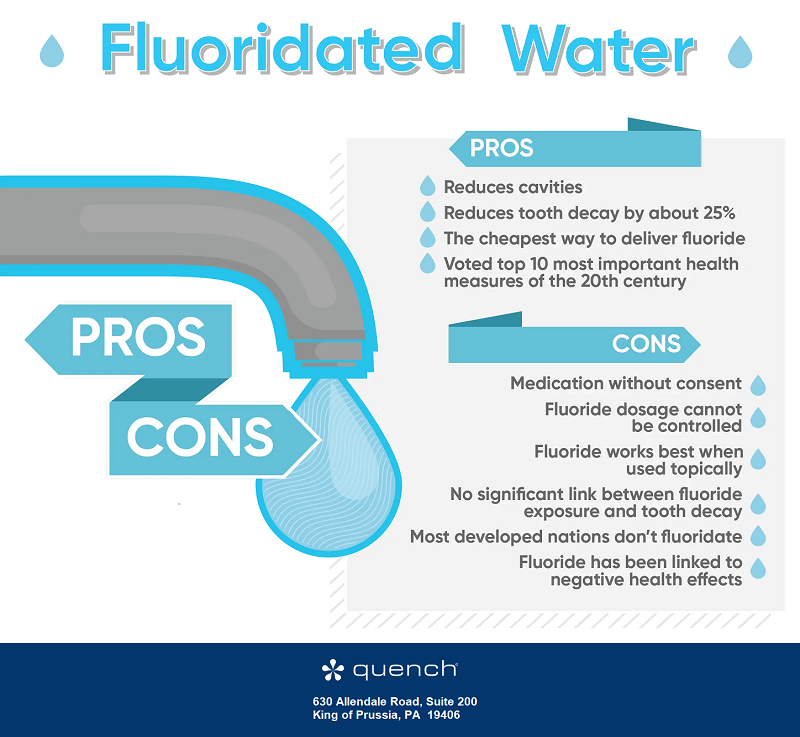The Fluoridation Debate: What's in the Water?

The Benefits and Risks
of Fluoride Exposure
In May 2024, a study published in the Journal of the American Medical Association concluded that prenatal fluoride exposure was associated with increased neurobehavioral problems in children and limiting fluoride exposure in pregnant women may be recommended.
In August 2024, the National Toxicology Program released a report stating that drinking water with a higher fluoride concentration than the recommended 0.7 mg was associated with lower IQ levels in children.
In September 2024, a federal judge ruled that the U.S. Environmental Protection Agency must address the impact of fluoride on public water systems. However, the ruling did not ban or otherwise limit the addition of fluoride to public water.
In November 2024, Florida Surgeon General Dr. Joseph Ladapo became the first state officer to publicly recommend that communities stop adding fluoride to their water systems.
Meanwhile, the American Dental Association remains “staunchly in support” of community water fluoridation at optimal levels to help prevent tooth decay.
These and other recent events have fueled an intense and controversial national debate around the benefits and risks of fluoride exposure. Let’s sort out the opposing views.
How It Began
Fluoride was first discovered to inhibit tooth decay in 1901. Over the next 40 years, research revealed that adding fluoride to drinking water prevented cavities and improved oral health.
In 1945, Grand Rapids, Mich., became the first city to add fluoride to its public water system. Today, nearly three-quarters of the U.S. population – about 209 million people – are served by fluoridated water, according to the Centers for Disease Control and Prevention (CDC).
Water fluoridation has been considered a cheap decay-prevention strategy and a significant public health achievement. However, new research has raised questions about both its safety and effectiveness.
Is Water Fluoridation Still Necessary?
Recent reports suggest the benefits of adding fluoride to public water systems may not be as significant as they once were.
--Article Continues Below--

While research prior to 1975 showed extensive benefits, an October 2024 report from the Cochrane Collaboration found that water fluoridation resulted in only slightly fewer cavities in children’s baby teeth. Specifically, children living in areas with fluoridated water averaged about one less cavity than those without water fluoridation.
The researchers concluded that current U.S. populations have broader access to alternative fluoride sources, particularly toothpaste, which has become widely available and more commonly used since the 1970s. As a result, they said, water fluoridation may have little to no general effect on tooth decay.
Still, proponents of fluoridation claim that it is the most cost-effective means for ensuring all communities receive the benefits of cavity prevention.
The Question of Health Equity
Steven Levy, a professor of preventive and community dentistry at the University of Iowa’s College of Dentistry, is very concerned about removing fluoride from public drinking water.
“As a society, we’ve partly forgotten how bad cavity problems were 50, 60, 70 years ago when most people, prior to that, had very few teeth. It’s unfortunate when people are quick to dismiss that,” he said.
According to Levy, there are still communities that suffer from cavity problems and who continue to benefit substantially from water fluoridation. People dealing with poverty or lack of access to dental care may not be able to prioritize oral hygiene. Toothbrushes, toothpaste, and dental floss can be too costly for them, and regular dental visits are out of the question. Water fluoridation, therefore, helps those who are “not fortunate enough to have access to individual-level fluoride exposures.”

About Dental Fluorosis
About 23% of the U.S. population is affected by dental fluorosis. This condition occurs when children consume too much fluoride while their teeth are growing, resulting in white spots or lines on the enamel.
Most cases of dental fluorosis in the U.S. are mild and primarily cosmetic. However, in countries with high levels of naturally occurring fluoride in drinking water (such as India), the condition can be severe, causing extensive damage to tooth enamel
To prevent fluorosis, the CDC recommends limiting a child’s exposure to fluoridated water and fluoride products prior to age 6.
Source: CDC
The CDC agrees. In a statement last May, the agency said: “Water fluoridation has been identified as the most cost-effective method of delivering fluoride to all members of the community regardless of age, educational attainment, or income level.”
The American Academy of Pediatrics also continues to support the use of fluoride, citing the chronic effects of cavities -- which are both common and preventable. To be sure, we’re talking about more than a toothache here. When left untreated, tooth decay can result in severe infection, heart disease, and death.
Mounting Evidence of Risk
But emerging research elevates concerns about the risks of fluoride exposure.
Much of that research was conducted in other countries. A study of pregnant women in Canada, for instance, linked fluoride exposure to lower IQ among children ages 3 to 4 years old. Likewise, a Mexican study associated fluoride exposure with lower IQ, attention-deficit/hyperactivity disorder (ADHD), and reduced brain function among children 6-12 years old.
The risks also include dental fluorosis, a condition that can cause speckles on tooth enamel. (See sidebar, “About Dental Fluorosis.”)
Going Forward
Many questions remain. How much fluoride is safe for pregnant women and their babies? At what age do the adverse effects of fluoride manifest? How should policymakers weigh the benefits of decay prevention with the risks of compromised brain function?
As we continue to learn more about the impacts of fluoride, we must rely on the scientific data proffered on both sides of the issue and the wisdom of our elected officials to effectively address the problem.
Sources:
Featured Image: Adobe, License Granted
Journal of the American Medical Association
CourtListener
Becker's Dental Review
The Hill
Cochrane Library
CNN
Recent Posts











Share On: